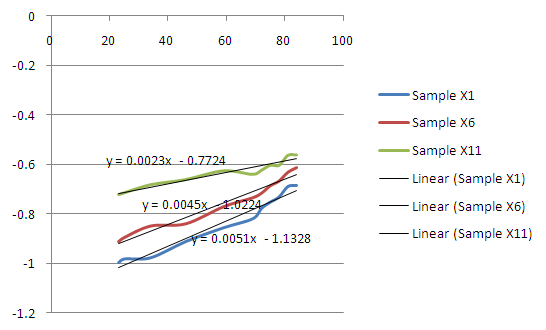Team:Imperial College London/Wetlab/Results/Colanic
From 2009.igem.org
(→Effect of Ph on non-colanic acid cell culture (absorbance)) |
(→Effect of pH on non-colanic acid cell culture (absorbance)) |
||
| Line 24: | Line 24: | ||
==Effect of pH on non-colanic acid cell culture (absorbance)== | ==Effect of pH on non-colanic acid cell culture (absorbance)== | ||
[[Image:II09_table2.png]]<br> | [[Image:II09_table2.png]]<br> | ||
| - | <b>Table 2: Growth rate at different | + | <b>Table 2: Growth rate at different pH values for cells without colanic acid </b><br> |
[[Image:II09_nooocolanic_ph11.png]]<br> | [[Image:II09_nooocolanic_ph11.png]]<br> | ||
| - | <b>Figure 2: Plots of log [absorbance] (optical density) for cells with no colanic acid.</b> Samples C1, C6 and C11 contain cells induced with colanic acid. The linear description stands for linear regression, which was used to estimate the growth rate for different | + | <b>Figure 2: Plots of log [absorbance] (optical density) for cells with no colanic acid.</b> Samples C1, C6 and C11 contain cells induced with colanic acid. The linear description stands for linear regression, which was used to estimate the growth rate for different pH values.<br> |
*C1 growth rate:0.0034 | *C1 growth rate:0.0034 | ||
*C6 growth rate:0.0038 | *C6 growth rate:0.0038 | ||
Revision as of 02:40, 22 October 2009

Contents |
Background
RcsB (biobrick BBa_K200000 is the gene responsible for generating a colanic acid capsule around our bacteria. Having a colanic acid capsule around them will protect them from being degraded by the high acidic nature of the stomach environment.
Aim
Here, as proof of concept, we have designed a simple experiment that will show that colanic acid has a protective effect on our growing bacteria in acidic environments (simulating gastric conditions). The method is described below.
Experimental Method
In a multiple well plate, 2 different types of cell cultures were grown, both containing the BBa_I13522 construct, which is a constitutive promoter expressing GFP. The differences were:
- Some cultures contained colanic acid (chemically induced by p-Fluoro-L-phenylalanine (FPA))
- Some cultures did not contain colanic acid.
Growth rate of the cell cultures and levels of GFP expression were monitored over time, at different Ph values in order to decide if induction using colanic acid provides extra protection to the construct.
Results analysis
Effect of pH on colanic acid cell culture (absorbance)

Table 1: Growth rate at different pH values for cells with colanic acid

Figure 1: Plots of log [absorbance] (optical density) for chemically induced colanic acid cells at pH = 1. Samples X1, X6 and X11 contain cells induced with colanic acid. The linear description stands for linear regression, which was used to estimate the growth rate for different pH values.
- X1 growth rate: 0.0023 /min
- X6 growth rate: 0.0045 /min
- X11 growth rate: 0.0051 /min
Effect of pH on non-colanic acid cell culture (absorbance)

Table 2: Growth rate at different pH values for cells without colanic acid

Figure 2: Plots of log [absorbance] (optical density) for cells with no colanic acid. Samples C1, C6 and C11 contain cells induced with colanic acid. The linear description stands for linear regression, which was used to estimate the growth rate for different pH values.
- C1 growth rate:0.0034
- C6 growth rate:0.0038
- C11 growth rate:0.0028
Conclusion
On average, cell growth is slighly faster in the presence of colanic acid. However, this experiment will be repeated before the jamboree, to ensure that large variations in some cases are not due to faults in our plate reader.
 "
"



